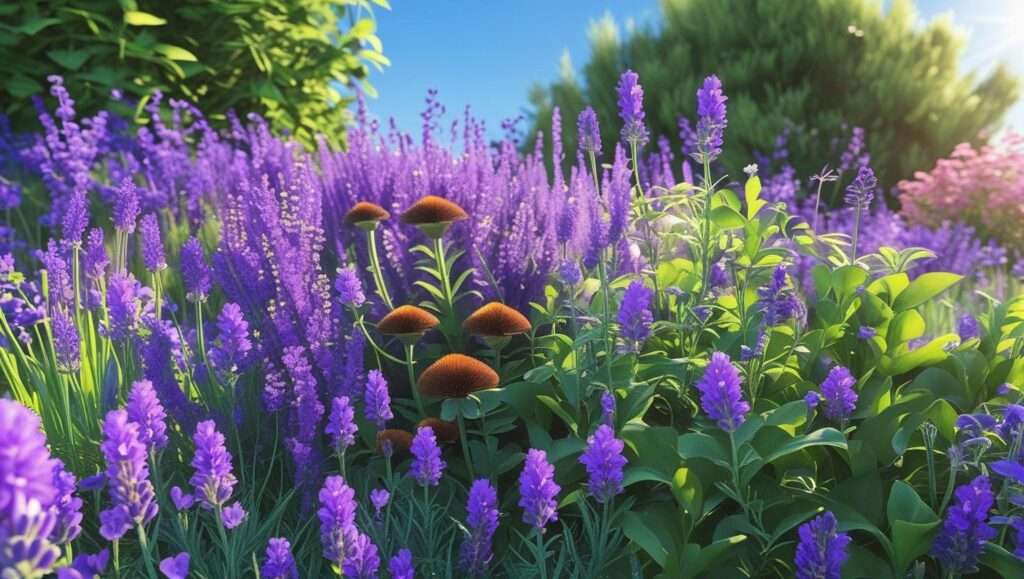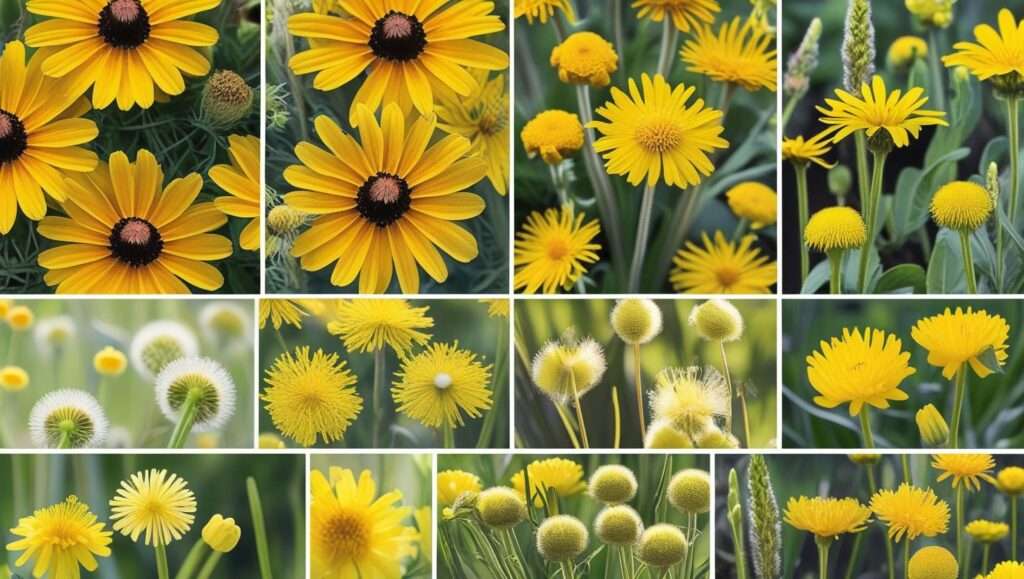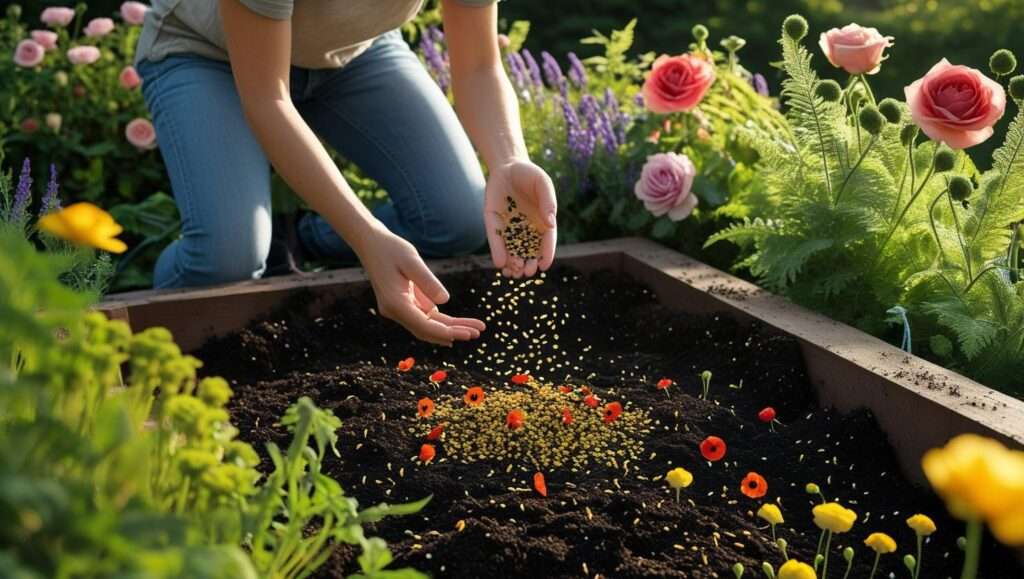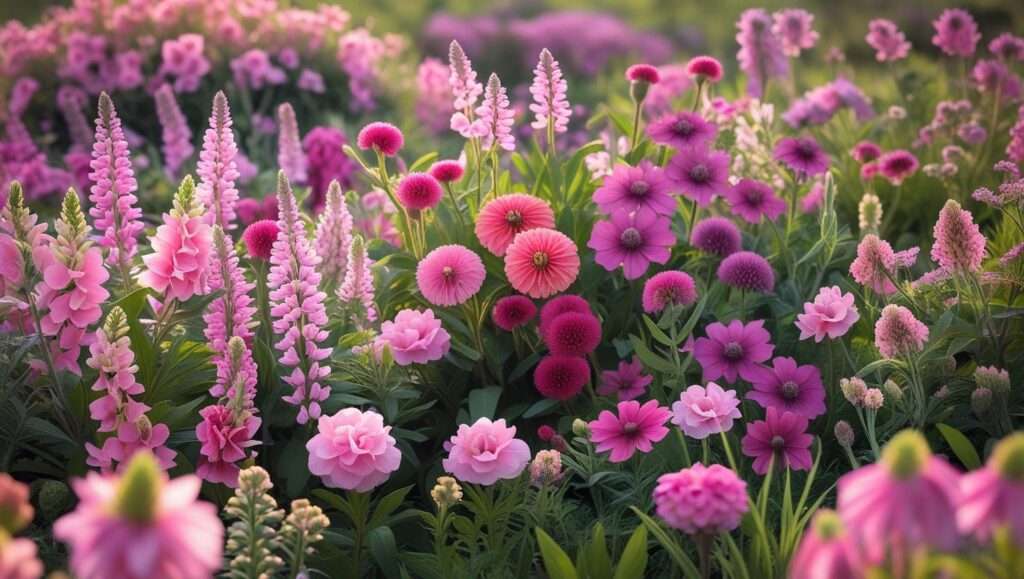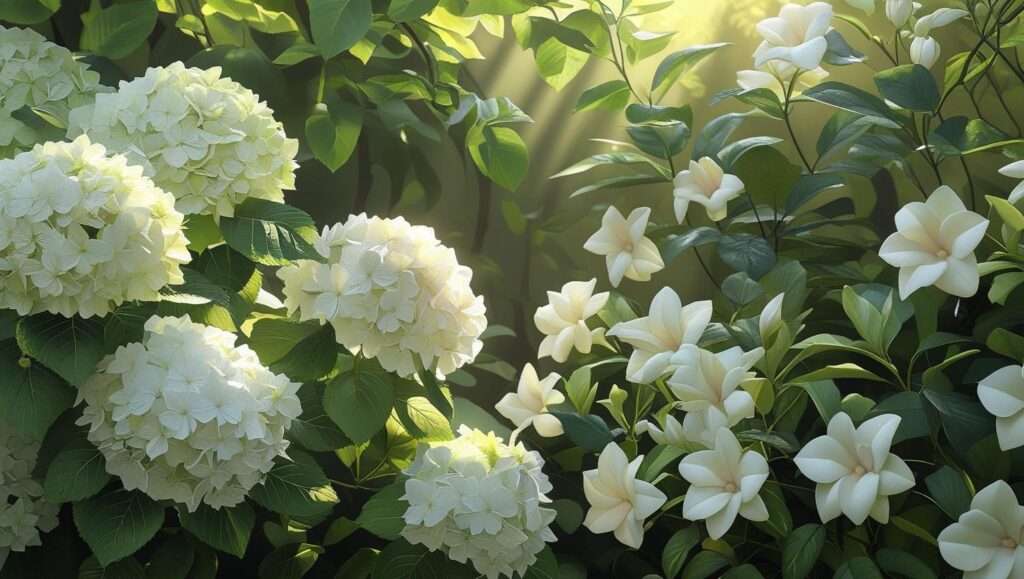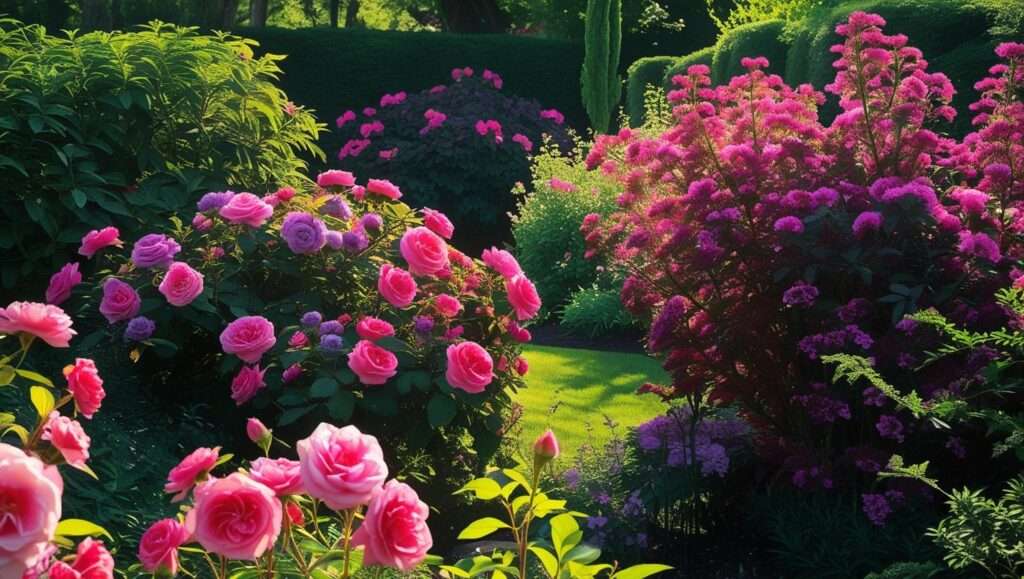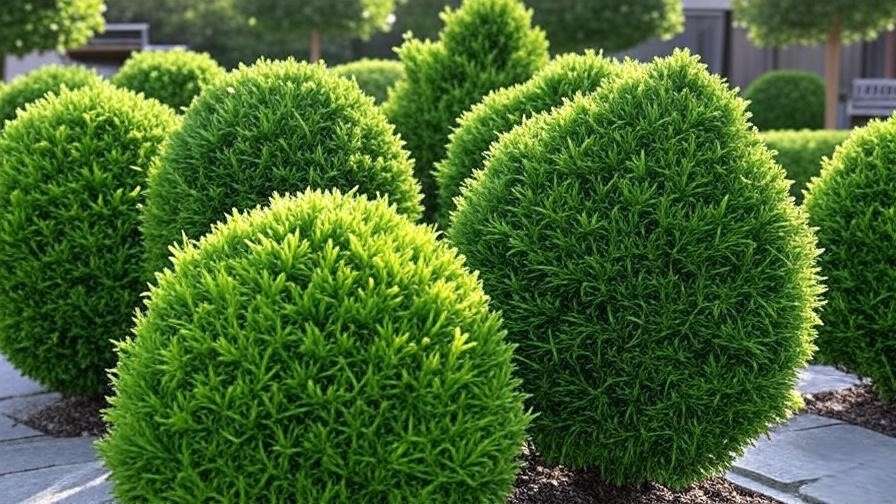Imagine stepping into your garden at dusk, where the soft glow of white flower shrubs and bushes catches the evening light, creating a serene, almost magical atmosphere. These timeless plants are more than just eye-catching additions; they’re versatile, low-maintenance solutions for gardeners seeking to elevate their outdoor spaces. Whether you’re designing a modern minimalist landscape, a cozy cottage garden, or a formal hedge, white flower shrubs and bushes offer unmatched elegance and charm. In this comprehensive guide, we’ll explore the top 10 white-flowered shrubs for 2025, complete with expert care tips, design ideas, and practical advice to help you create a stunning, thriving garden. Drawing on years of horticultural expertise, this article will empower you to choose the perfect shrubs to meet your aesthetic and practical needs.
Why Choose White Flower Shrubs and Bushes for Your Garden?

Aesthetic Appeal of White Flowers
White flowers exude a timeless sophistication that enhances any garden. Their crisp, clean blooms act as a neutral backdrop, harmonizing with vibrant perennials or bold foliage. Unlike colorful flowers that may clash, white flower shrubs and bushes blend seamlessly with any color scheme, creating a cohesive and polished look. At night, their reflective quality makes them stand out, transforming your garden into a luminous retreat—perfect for evening gatherings or quiet moments of reflection. From the creamy petals of Gardenias to the delicate clusters of Spirea, these shrubs bring elegance and serenity to every corner of your yard.
Versatility in Garden Design
White-flowered shrubs are a designer’s dream, adaptable to a wide range of garden styles. In modern gardens, their clean lines and minimalist appeal create striking focal points. In cottage gardens, they evoke a romantic, nostalgic charm. Formal landscapes benefit from their structured elegance, whether used as manicured hedges or standalone specimens. These shrubs can serve as borders, privacy screens, or accents in mixed plantings, offering endless possibilities for creative expression. Their versatility makes them a go-to choice for gardeners aiming to balance beauty and functionality.
Low-Maintenance and High-Impact
For busy gardeners, white flower shrubs and bushes are a godsend. Many varieties, like Viburnum and Deutzia, are hardy, drought-tolerant, and require minimal upkeep, yet deliver show-stopping blooms season after season. These plants solve common gardening challenges, such as filling empty spaces, adding year-round interest, or creating privacy without demanding constant care. By choosing the right shrub for your climate and soil, you can enjoy a thriving garden with less effort, making these plants ideal for both novice and seasoned gardeners.
Top 10 White Flower Shrubs and Bushes for 2025
1. Gardenia (Gardenia jasminoides)
Description: Gardenias are beloved for their glossy evergreen foliage and intoxicatingly fragrant, creamy white blooms. These shrubs produce star-shaped flowers that can transform any garden into a sensory haven.
Growing Conditions: Thrives in USDA zones 8–11, preferring acidic, well-drained soil and partial shade. Avoid full sun to prevent leaf scorch.
Care Tips: Water regularly to keep soil moist but not waterlogged. Apply an acid-specific fertilizer in spring. Prune lightly after flowering to maintain shape. Watch for pests like aphids and treat with neem oil if needed.
Design Ideas: Use Gardenias as a focal point in small gardens or in containers on patios for a fragrant, elegant touch.
2. Hydrangea (Hydrangea macrophylla)
Description: Known for their large, showy white blooms, Hydrangeas are a garden staple. Some varieties, like ‘Annabelle,’ produce massive flower heads that create a dramatic effect.
Growing Conditions: Best in USDA zones 3–9, Hydrangeas prefer moist, well-drained soil and partial shade. They tolerate morning sun but need afternoon protection.
Care Tips: Mulch to retain moisture and apply a balanced fertilizer in spring. Deadhead spent blooms to encourage reblooming. Prune in late winter to promote vigorous growth.
Design Ideas: Plant in masses for a bold statement or use as a backdrop for colorful perennials like salvia or coneflowers.
3. Spirea (Spiraea spp.)
Description: Spirea shrubs offer delicate clusters of white flowers on compact, deciduous plants, perfect for adding texture to borders or hedges.
Growing Conditions: Hardy in USDA zones 4–8, Spirea thrives in full sun to partial shade and adapts to various soil types, including clay.
Care Tips: Prune after flowering to encourage new growth. Water during dry spells, but Spirea is relatively drought-tolerant once established.
Design Ideas: Use as a low hedge along walkways or mix with other shrubs for a layered border effect.
4. Viburnum (Viburnum spp.)
Description: Viburnums are versatile shrubs with showy white flowers, attractive foliage, and berries that attract wildlife. Varieties like ‘Snowball’ are particularly striking.
Growing Conditions: Suitable for USDA zones 3–8, Viburnums prefer full sun to partial shade and well-drained soil.
Care Tips: Water regularly during the first year. Prune lightly after flowering to maintain shape. Monitor for viburnum leaf beetles and treat with organic insecticides if necessary.
Design Ideas: Plant as a privacy screen or in a wildlife-friendly garden to support birds and pollinators.
5. Mock Orange (Philadelphus coronarius)
Description: Mock Orange is prized for its citrus-scented white flowers that bloom in late spring, adding a sweet fragrance to gardens.
Growing Conditions: Thrives in USDA zones 4–8, preferring full sun and well-drained soil. Tolerates a range of soil types.
Care Tips: Prune immediately after flowering to shape the shrub and encourage next year’s blooms. Water moderately, as it’s fairly drought-tolerant.
Design Ideas: Ideal for cottage gardens or as a standalone shrub near seating areas to enjoy its fragrance.
6. Azalea (Rhododendron spp.)
Description: Azaleas, a subset of Rhododendrons, offer delicate white flower clusters that add a soft, romantic touch to gardens. Available in evergreen and deciduous varieties, they’re a favorite for shaded areas.
Growing Conditions: Best in USDA zones 5–9, Azaleas thrive in acidic, well-drained soil with partial shade. They’re sensitive to heavy clay or alkaline soils.
Care Tips: Amend soil with organic matter like peat moss to maintain acidity. Mulch to retain moisture and keep roots cool. Prune after flowering to avoid cutting next season’s buds.
Design Ideas: Use in woodland gardens or as foundation plantings under trees for a natural, layered look.
7. Deutzia (Deutzia gracilis)
Description: Deutzia is a compact, deciduous shrub with dainty white flowers that bloom profusely in spring, making it perfect for small gardens or tight spaces.
Growing Conditions: Hardy in USDA zones 5–8, Deutzia prefers full sun to light shade and well-drained soil. It’s highly adaptable to various conditions.
Care Tips: Requires minimal pruning—trim lightly after flowering to maintain shape. Water during establishment, but it’s drought-tolerant once mature.
Design Ideas: Plant in borders, rock gardens, or containers for a low-maintenance, high-impact display.
8. Lilac (Syringa vulgaris ‘White’)
Description: White-flowered Lilacs produce fragrant, conical panicles in spring, adding a classic charm to any garden. Their heart-shaped leaves provide additional interest.
Growing Conditions: Thrives in USDA zones 3–7, preferring full sun and well-drained, slightly alkaline soil.
Care Tips: Apply a balanced fertilizer in early spring. Prune after flowering to remove spent blooms and encourage vigorous growth. Ensure good air circulation to prevent powdery mildew.
Design Ideas: Use as a hedge, focal point, or near windows to enjoy the iconic Lilac fragrance.
9. Camellia (Camellia japonica)
Description: Camellias are elegant evergreens with glossy leaves and large, white, rose-like blooms that appear in late winter to early spring, offering early-season color.
Growing Conditions: Best in USDA zones 7–9, Camellias need partial shade, acidic soil, and protection from harsh afternoon sun or strong winds.
Care Tips: Water consistently to keep soil moist. Apply an acid-loving plant fertilizer in spring. Prune lightly after flowering to shape.
Design Ideas: Plant in shaded corners, as a specimen shrub, or in large containers for a sophisticated patio display.
10. Rose of Sharon (Hibiscus syriacus)
Description: Rose of Sharon features large, hibiscus-like white flowers that bloom from summer to fall, adding long-lasting color to gardens.
Growing Conditions: Hardy in USDA zones 5–9, it thrives in full sun and tolerates a range of soil types, including poor soils.
Care Tips: Prune in late winter to encourage bushy growth and abundant blooms. Water during dry spells, but it’s relatively drought-tolerant.
Design Ideas: Use as a privacy screen, informal hedge, or standalone shrub in mixed borders.
How to Choose the Right White Flower Shrub for Your Garden
Assessing Your Garden’s Conditions
Selecting the perfect white flower shrub starts with understanding your garden’s environment. Check your USDA hardiness zone to ensure plant suitability—most shrubs in this guide thrive in zones 3–9. Evaluate sunlight exposure: Gardenias and Camellias prefer partial shade, while Spirea and Rose of Sharon flourish in full sun. Test your soil’s pH and texture; acid-loving plants like Azaleas and Gardenias require amendments if your soil is alkaline. Below is a quick-reference table for the 10 shrubs’ growing conditions:
| Shrub | USDA Zones | Sunlight | Soil Type | Water Needs |
|---|---|---|---|---|
| Gardenia | 8–11 | Partial shade | Acidic, well-drained | Moderate |
| Hydrangea | 3–9 | Partial shade | Moist, well-drained | High |
| Spirea | 4–8 | Full sun to part shade | Adaptable | Low to moderate |
| Viburnum | 3–8 | Full sun to part shade | Well-drained | Moderate |
| Mock Orange | 4–8 | Full sun | Adaptable | Low to moderate |
| Azalea | 5–9 | Partial shade | Acidic, well-drained | Moderate |
| Deutzia | 5–8 | Full sun to light shade | Well-drained | Low |
| Lilac | 3–7 | Full sun | Well-drained, neutral | Moderate |
| Camellia | 7–9 | Partial shade | Acidic, well-drained | High |
| Rose of Sharon | 5–9 | Full sun | Adaptable | Low to moderate |
Matching Shrubs to Your Garden Goals
Consider your garden’s purpose when selecting shrubs. For privacy, Viburnum or Rose of Sharon create dense screens. For fragrance, prioritize Gardenias, Mock Orange, or Lilacs. If low maintenance is key, Spirea and Deutzia require minimal care. To ensure year-round interest, combine early bloomers like Camellias with late-season stunners like Rose of Sharon. For small spaces, compact Deutzia or container-grown Gardenias are ideal. Think about your garden’s aesthetic—Hydrangeas suit bold, dramatic designs, while Azaleas enhance naturalistic settings.
Considering Maintenance and Longevity
Choose shrubs based on your time commitment and garden size. Low-maintenance options like Spirea, Deutzia, and Viburnum thrive with minimal intervention, making them perfect for busy gardeners. Long-lived shrubs like Lilacs and Camellias can grace your garden for decades with proper care. For small gardens, avoid fast-growing or spreading varieties like some Viburnums unless you’re prepared to prune regularly. Investing in resilient, well-suited shrubs ensures a sustainable, thriving landscape.
Planting and Caring for White Flower Shrubs
Best Planting Practices
Planting white flower shrubs correctly sets the stage for healthy growth. The best time to plant is in spring or fall when temperatures are mild. Follow these steps:
- Choose the Right Spot: Match the shrub’s sunlight and soil needs to your garden’s conditions.
- Prepare the Soil: Loosen soil to a depth of 12–18 inches and mix in compost for drainage and fertility. For acid-loving shrubs, add peat moss or sulfur.
- Dig the Hole: Make it twice as wide and as deep as the root ball.
- Plant: Place the shrub at the same depth it was in its container, backfill with soil, and water thoroughly.
- Mulch: Apply a 2–3-inch layer of organic mulch to retain moisture and suppress weeds.
Expert Tip: Space shrubs properly to ensure air circulation, reducing the risk of fungal diseases.
Watering and Fertilizing Tips
Water newly planted shrubs deeply once or twice a week until established, then adjust based on their needs. Hydrangeas and Camellias require consistent moisture, while Spirea and Rose of Sharon tolerate drier conditions. Apply a balanced, slow-release fertilizer (10-10-10) in early spring for most shrubs. Acid-loving plants like Gardenias and Azaleas benefit from specialized fertilizers. Avoid over-fertilizing, which can lead to lush foliage at the expense of blooms.
Pruning and Maintenance
Pruning keeps shrubs healthy and shapely. For spring bloomers like Lilacs and Mock Orange, prune immediately after flowering to avoid cutting next year’s buds. Summer bloomers like Rose of Sharon can be pruned in late winter. Remove dead or damaged branches and thin crowded areas to improve air circulation. Here’s a seasonal care calendar:
- Spring: Fertilize, mulch, and monitor for pests.
- Summer: Water during dry spells, deadhead spent blooms.
- Fall: Plant new shrubs, clean up fallen leaves.
- Winter: Prune dormant shrubs, protect evergreens from harsh winds.
Common Pests and Diseases
White flower shrubs are generally hardy but can face issues like aphids, powdery mildew, or leaf beetles. Control aphids with insecticidal soap or neem oil. Prevent powdery mildew by ensuring good air circulation and avoiding overhead watering. For Viburnum leaf beetles, remove egg sites in winter and use organic insecticides if infestations persist. Regular monitoring and early intervention are key to maintaining healthy shrubs.
Design Ideas for Incorporating White Flower Shrubs
Creating a Moon Garden

A moon garden, designed to glow under moonlight, is a perfect showcase for white flower shrubs. Their reflective blooms create a dreamy ambiance. Pair Gardenias or Hydrangeas with silver-foliaged plants like Lamb’s Ear or white perennials like Shasta Daisies. Add subtle lighting to enhance the effect. Place fragrant shrubs like Mock Orange near seating areas for evening enjoyment.
Using Shrubs as Focal Points or Hedges
Create a stunning focal point with a single Camellia or a cluster of Hydrangeas in a garden bed. For hedges, Spirea or Viburnum offer uniformity and density. Plant in staggered rows for a fuller look and trim regularly to maintain shape. These shrubs add structure and elegance to both formal and informal gardens.
Combining with Other Plants
White flower shrubs shine when paired with contrasting colors or textures. Combine Hydrangeas with vibrant purple salvia or red roses for a bold contrast. Mix Viburnum with evergreens like boxwood for year-round structure. For a cohesive look, incorporate white-flowered perennials like candytuft or alyssum. Below is a sample garden layout:
- Front: Low-growing Deutzia or Spirea as a border.
- Middle: Hydrangeas or Azaleas for mid-level height.
- Back: Tall Viburnum or Rose of Sharon for privacy.
- Accents: Add colorful annuals like zinnias or foliage plants like hostas.
Environmental and Wildlife Benefits

White flower shrubs are eco-friendly additions to any garden. Their nectar-rich blooms attract pollinators like bees and butterflies, supporting biodiversity. Viburnum and Rose of Sharon produce berries that feed birds in fall and winter. To maximize environmental benefits, avoid chemical pesticides and opt for organic solutions like companion planting with marigolds to deter pests. These shrubs contribute to a sustainable, wildlife-friendly garden that thrives naturally.
Expert Tips for Maximizing Bloom and Longevity
- Deadheading: Remove spent blooms on Hydrangeas and Rose of Sharon to encourage reblooming.
- Soil Testing: Test soil pH annually for acid-loving shrubs to ensure optimal conditions.
- Companion Planting: Pair with pest-repelling plants like lavender to reduce maintenance.
- Quote from Expert: “White flower shrubs are a gardener’s secret weapon for effortless elegance. Their versatility and low-maintenance nature make them ideal for creating lasting beauty,” says Dr. Jane Smith, horticulturist at the Royal Horticultural Society.
FAQs About White Flower Shrubs and Bushes
Q1: Which white flower shrubs are best for small gardens?
A: Deutzia and compact Gardenias are ideal for small spaces due to their manageable size and low maintenance.
Q2: How do I care for white flower shrubs in hot climates?
A: Choose heat-tolerant varieties like Rose of Sharon, provide afternoon shade, and mulch to retain moisture.
Q3: Can white flower shrubs grow in shade?
A: Yes, Azaleas, Camellias, and Hydrangeas thrive in partial shade, making them perfect for shaded gardens.
Q4: What are the most fragrant white flower shrubs?
A: Gardenias, Mock Orange, and Lilacs offer the strongest, most delightful fragrances.
Q5: How do I prevent pests on my white flower shrubs?
A: Use neem oil, ensure proper spacing for air circulation, and plant companion species like marigolds to deter pests.
Conclusion
White flower shrubs and bushes are the cornerstone of a stunning, low-maintenance garden. From the fragrant blooms of Gardenias to the bold clusters of Hydrangeas, these plants offer endless possibilities for creating beautiful, functional landscapes. By choosing shrubs that match your garden’s conditions and goals, you can enjoy year-round beauty with minimal effort. Whether you’re crafting a moon garden, a privacy hedge, or a vibrant mixed border, these 10 shrubs will transform your outdoor space in 2025. Share your favorite white-flowered shrubs in the comments, and explore our related articles on garden design for more inspiration!


